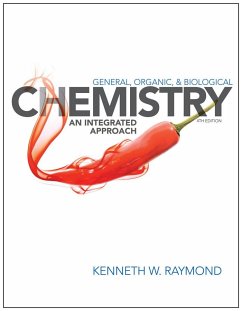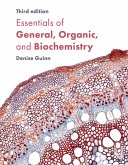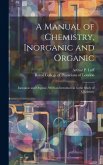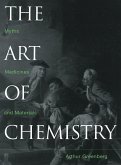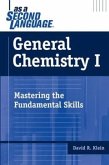- Gebundenes Buch
- Merkliste
- Auf die Merkliste
- Bewerten Bewerten
- Teilen
- Produkt teilen
- Produkterinnerung
- Produkterinnerung
This General, Organic and Biochemistry text has been written for students preparing for careers in health-related fields such as nursing, dental hygiene, nutrition, medical technology and occupational therapy. It is also suited for students majoring in other fields where it is important to have an understanding of the basics of chemistry. An integrated approach is employed in which related general chemistry, organic chemistry, and biochemistry topics are presented in adjacent chapters. This approach helps students see the strong connections that exist between these three branches of chemistry,…mehr
Andere Kunden interessierten sich auch für
![Essentials of General, Organic, and Biochemistry (International Edition) Essentials of General, Organic, and Biochemistry (International Edition)]() Denise GuinnEssentials of General, Organic, and Biochemistry (International Edition)112,99 €
Denise GuinnEssentials of General, Organic, and Biochemistry (International Edition)112,99 €![A Manual of Chemistry, Inorganic and Organic: Inorganic and Organic, With an Introduction to the Study of Chemistry A Manual of Chemistry, Inorganic and Organic: Inorganic and Organic, With an Introduction to the Study of Chemistry]() A Manual of Chemistry, Inorganic and Organic: Inorganic and Organic, With an Introduction to the Study of Chemistry44,99 €
A Manual of Chemistry, Inorganic and Organic: Inorganic and Organic, With an Introduction to the Study of Chemistry44,99 €![Organic, Physical, and Materials Photochemistry Organic, Physical, and Materials Photochemistry]() V. Ramamurthy / Kirk S. Schanze (eds.)Organic, Physical, and Materials Photochemistry358,99 €
V. Ramamurthy / Kirk S. Schanze (eds.)Organic, Physical, and Materials Photochemistry358,99 €![Outlines of Modern Chemistry, Organic, based in Part Upon Riches' Manuel de Chimie Outlines of Modern Chemistry, Organic, based in Part Upon Riches' Manuel de Chimie]() Charles Gilbert WheelerOutlines of Modern Chemistry, Organic, based in Part Upon Riches' Manuel de Chimie36,99 €
Charles Gilbert WheelerOutlines of Modern Chemistry, Organic, based in Part Upon Riches' Manuel de Chimie36,99 €![The Art of Chemistry The Art of Chemistry]() Arthur GreenbergThe Art of Chemistry148,99 €
Arthur GreenbergThe Art of Chemistry148,99 €![Excel for Chemists, Excel for Chemists,]() E. Joseph BilloExcel for Chemists,77,99 €
E. Joseph BilloExcel for Chemists,77,99 €![General Chemistry I as a Second Language General Chemistry I as a Second Language]() David R. KleinGeneral Chemistry I as a Second Language69,99 €
David R. KleinGeneral Chemistry I as a Second Language69,99 €-
-
-
This General, Organic and Biochemistry text has been written for students preparing for careers in health-related fields such as nursing, dental hygiene, nutrition, medical technology and occupational therapy. It is also suited for students majoring in other fields where it is important to have an understanding of the basics of chemistry. An integrated approach is employed in which related general chemistry, organic chemistry, and biochemistry topics are presented in adjacent chapters. This approach helps students see the strong connections that exist between these three branches of chemistry, and allows instructors to discuss these, interrelationships while the material is still fresh in students minds.
Hinweis: Dieser Artikel kann nur an eine deutsche Lieferadresse ausgeliefert werden.
Hinweis: Dieser Artikel kann nur an eine deutsche Lieferadresse ausgeliefert werden.
Produktdetails
- Produktdetails
- Verlag: Wiley & Sons
- 4. Aufl.
- Seitenzahl: 672
- Erscheinungstermin: 4. Januar 2013
- Englisch
- Abmessung: 277mm x 218mm x 25mm
- Gewicht: 984g
- ISBN-13: 9781118352588
- ISBN-10: 1118352580
- Artikelnr.: 36146402
- Herstellerkennzeichnung
- Libri GmbH
- Europaallee 1
- 36244 Bad Hersfeld
- gpsr@libri.de
- Verlag: Wiley & Sons
- 4. Aufl.
- Seitenzahl: 672
- Erscheinungstermin: 4. Januar 2013
- Englisch
- Abmessung: 277mm x 218mm x 25mm
- Gewicht: 984g
- ISBN-13: 9781118352588
- ISBN-10: 1118352580
- Artikelnr.: 36146402
- Herstellerkennzeichnung
- Libri GmbH
- Europaallee 1
- 36244 Bad Hersfeld
- gpsr@libri.de
Kenneth W. Raymond is the author of General Organic and Biological Chemistry: An Integrated Approach, 4th Edition, published by Wiley.
chapter 1 Science and Measurements 1
1.1 The Scientific Method 2
HealthLink Science and Medicine5
1.2 Matter and Energy 5
1.3 Units of Measurement 9
1.4 Scientific Notation, SI and Metric Prefixes 13
1.5 Measurements and Significant Figures 15
HealthLink Body Mass Index 18
HealthLink Body Temperature 21
1.6 Conversion Factors and the Factor Label Method 22
1.7 Density, Specific Gravity, and Specific Heat 25
HealthLink Making Weight 28
1.8 Measurements in General Chemistry,Organic Chemistry, and Biochemistry
29
chapter 2 A toms and Elements 42
2.1 Atoms 44
2.2 Elements 46
2.3 Trace Elements 48
2.4 Atomic Number and Mass Number 51
HealthLink Stable Isotopes and Drug Testing 53
2.5 Periodic Table 54
HealthLink Lead 58
2.6 The Mole 59
2.7 The Arrangement of Electrons 62
BiochemistryLink Bioluminescence 67
2.8 Radioactive Isotopes 68
2.9 Radioisotopes in Medicine 71
HealthLink Radioisotopes for Sale 79
HealthLink CT and MRI Imaging 79
chapter 3 Compounds 88
3.1 Ions 90
3.2 The Octet Rule 93
BiochemistryLink Ionophores and Biological Ion Transport 95
3.3 Ionic Compounds 96
HealthLink Pass the Salt, Please 100
3.4 Covalent Bonds 101
3.5 Molecules 103
HealthLink Dental Fillings 105
3.6 Formula Weight, Molecular Weight,and Molar Mass 105
HealthLink Nitric Oxide 108
chapter 4 An Introduct ion to Organic Compounds 116
4.1 Structural Formulas 118
4.2 Polar Covalent Bonds, Shape, and Polarity 123
HealthLink Prion Diseases 128
4.3 Noncovalent Interactions 130
4.4 Families of Organic Compounds 132
BiochemistryLink Ethylene, a Plant Hormone 134
HealthLink Sunscreens 139
chapter 5 Reactions 150
5.1 Chemical Equations 152
5.2 Reaction Types 156
5.3 Reactions Involving Water 158
5.4 Oxidation and Reduction 161
HealthLink Antiseptics and Oxidation 166
5.5 Mole and Mass Relationships in Reactions 167
5.6 Calculating the Yield of a Reaction 171
5.7 Free Energy and Reaction Rate 174
HealthLink Carbonic Anhydrase 177
chapter 6 Gases, Solutions,Colloids, and Suspensions 190
6.1 Gases and Pressure 192
HealthLink Blood Pressure 196
6.2 The Gas Laws 197
6.3 Partial Pressure 202
HealthLink Breathing 203
6.4 Solutions 204
6.5 Precipitation Reactions 207
6.6 Solubility of Gases in Water 209
6.7 Organic and Biochemical Compounds 212
HealthLink Prodrugs 215
6.8 Concentration 216
6.9 Dilution 221
6.10 Colloids and Suspensions 222
HealthLink Saliva 224
6.11 Diffusion and Osmosis 225
HealthLink Diffusion and the Kidneys 227
chapter 7 Acids, Bases, and Equilibrium 238
7.1 Acids and Bases 240
7.2 Brønsted-Lowry Acids and Bases 241
7.3 Equilibrium 243
7.4 Le Châtelier's Principle 246
BiochemistryLink Diving Mammals, Oxygen, and Myoglobin 249
7.5 Ionization of Water 250
7.6 The pH Scale 251
7.7 Acid and Base Strength 254
BiochemistryLink Plants as pH Indicators 257
7.8 Neutralizing Acids and Bases 257
7.9 Effect of pH on Acid and Conjugate Base Concentrations 259
7.10 Buffers 261
BiochemistryLink The Henderson-Hasselbalch Equation 262
7.11 Maintaining the pH of Blood Serum 263
chapter 8 Organic Reactions 1-Hydrocarbons,Carboxylic Acids,Amines, and
Related Compounds 276
8.1 Alkanes 278
8.2 Constitutional Isomers 282
8.3 Conformations 284
8.4 Cycloalkanes 285
8.5 Alkenes, Alkynes, and Aromatic Compounds 287
8.6 Reactions of Hydrocarbons 291
8.7 Carboxylic Acids 297
8.8 Phenols 299
HealthLink A Chili Pepper Painkiller 300
8.9 Carboxylic Acids and Phenols as Weak Organic Acids 301
8.10 Preparing Esters 304
HealthLink Alpha Hydroxy Acids 306
8.11 Amines 307
HealthLink Adrenaline and Related Compounds 310
8.12 Amines as Weak Organic Bases 311
8.13 Amides 313
HealthLink Biofilms 315
BiochemistryLink A Cure for Fleas 316
chapter 9 Organic Reactions 2-Alcohols, Ethers, Aldehydes, and Ketones 334
9.1 Alcohols, Ethers, and Related Compounds 336
9.2 Preparation 339
9.3 Reactions 341
9.4 Aldehydes and Ketones 344
9.5 Oxidation of Aldehydes 347
HealthLink Aldehyde Dehydrogenase 349
9.6 Reduction of Aldehydes and Ketones 349
HealthLink Protective Enzymes 351
9.7 Reactions of Alcohols with Aldehydes and Ketones 352
HealthLink Drugs in the Environment 354
chapter 10 Carbohydrates 370
10.1 Monosaccharides 372
10.2 Stereoisomers 374
10.3 Important Monosaccharides and Monosaccharide Derivatives 381
10.4 Reactions of Monosaccharides 384
10.5 Monosaccharides in Their Cyclic Form 386
10.6 Oligosaccharides 390
HealthLink Natural and Artificial Sweeteners 397
HealthLink Stevia 400
10.7 Polysaccharides 401
chapter 11 Lipids and Membranes 420
11.1 Fatty Acids 422
HealthLink Omega-3 Fatty Acids 426
11.2 Waxes 427
11.3 Triglycerides 429
HealthLink Trans Fats 435
HealthLink Olestra 436
11.4 Phospholipids and Glycolipids 437
11.5 Steroids 441
HealthLink Anabolic Steroids 445
11.6 Eicosanoids 445
11.7 Membranes 447
chapter 12 Peptides, Proteins, and Enzymes 458
12.1 Amino Acids 460
12.2 The Peptide Bond 464
12.3 Peptides, Proteins, and pH 468
12.4 Protein Structure 469
BiochemistryLink Hemoglobin, a Globular Protein, and Collagen, a Fibrous
Protein 475
HealthLink Immunotherapy 476
12.5 Denaturation 477
12.6 Enzymes 478
12.7 Control of Enzyme-Catalyzed Reactions 482
HealthLink Tamiflu and Relenza as Enzyme Inhibitors 486
HealthLink Proteins in Medicine 489
chapter 13 Nucleic Acids 498
13.1 Nucleic Acid Building Blocks 500
13.2 Nucleoside Di- and Triphosphates, Cyclic Nucleotides 505
13.3 Polynucleotides 506
13.4 DNA Structure 509
13.5 Denaturation 512
13.6 Nucleic Acids and Information Flow 514
13.7 DNA Replication 515
13.8 Transcription and RNA 517
HealthLink Lupus 519
13.9 Translation 520
13.10 Control of Gene Expression 522
HealthLink RNA Interference 524
13.11 Mutation 524
13.12 Recombinant DNA 525
BiochemistryLink Glowing Cats 528
13.13 DNA Fingerprinting 529
chapter 14 Metabolism 540
14.1 Metabolic Pathways, Energy, and Coupled Reactions 542
14.2 Overview of Metabolism 543
14.3 Digestion 548
14.4 Glycolysis 551
14.5 Gluconeogenesis 556
14.6 Glycogen Metabolism 558
14.7 Citric Acid Cycle 560
14.8 Electron Transport Chain and Oxidative Phosphorylation 562
HealthLink Brown Fat 566
14.9 Lipid Metabolism 566
14.10 Amino Acid Metabolism 571
Appendix A Important Families of Organic Compounds 582
Appendix B Naming Ions, Ionic Compounds, Binary Molecules, and Organic
Compounds 584
Appendix C Answers to Odd-Numbered
Problems 591
Appendix D Glossary 639
Index I-1
1.1 The Scientific Method 2
HealthLink Science and Medicine5
1.2 Matter and Energy 5
1.3 Units of Measurement 9
1.4 Scientific Notation, SI and Metric Prefixes 13
1.5 Measurements and Significant Figures 15
HealthLink Body Mass Index 18
HealthLink Body Temperature 21
1.6 Conversion Factors and the Factor Label Method 22
1.7 Density, Specific Gravity, and Specific Heat 25
HealthLink Making Weight 28
1.8 Measurements in General Chemistry,Organic Chemistry, and Biochemistry
29
chapter 2 A toms and Elements 42
2.1 Atoms 44
2.2 Elements 46
2.3 Trace Elements 48
2.4 Atomic Number and Mass Number 51
HealthLink Stable Isotopes and Drug Testing 53
2.5 Periodic Table 54
HealthLink Lead 58
2.6 The Mole 59
2.7 The Arrangement of Electrons 62
BiochemistryLink Bioluminescence 67
2.8 Radioactive Isotopes 68
2.9 Radioisotopes in Medicine 71
HealthLink Radioisotopes for Sale 79
HealthLink CT and MRI Imaging 79
chapter 3 Compounds 88
3.1 Ions 90
3.2 The Octet Rule 93
BiochemistryLink Ionophores and Biological Ion Transport 95
3.3 Ionic Compounds 96
HealthLink Pass the Salt, Please 100
3.4 Covalent Bonds 101
3.5 Molecules 103
HealthLink Dental Fillings 105
3.6 Formula Weight, Molecular Weight,and Molar Mass 105
HealthLink Nitric Oxide 108
chapter 4 An Introduct ion to Organic Compounds 116
4.1 Structural Formulas 118
4.2 Polar Covalent Bonds, Shape, and Polarity 123
HealthLink Prion Diseases 128
4.3 Noncovalent Interactions 130
4.4 Families of Organic Compounds 132
BiochemistryLink Ethylene, a Plant Hormone 134
HealthLink Sunscreens 139
chapter 5 Reactions 150
5.1 Chemical Equations 152
5.2 Reaction Types 156
5.3 Reactions Involving Water 158
5.4 Oxidation and Reduction 161
HealthLink Antiseptics and Oxidation 166
5.5 Mole and Mass Relationships in Reactions 167
5.6 Calculating the Yield of a Reaction 171
5.7 Free Energy and Reaction Rate 174
HealthLink Carbonic Anhydrase 177
chapter 6 Gases, Solutions,Colloids, and Suspensions 190
6.1 Gases and Pressure 192
HealthLink Blood Pressure 196
6.2 The Gas Laws 197
6.3 Partial Pressure 202
HealthLink Breathing 203
6.4 Solutions 204
6.5 Precipitation Reactions 207
6.6 Solubility of Gases in Water 209
6.7 Organic and Biochemical Compounds 212
HealthLink Prodrugs 215
6.8 Concentration 216
6.9 Dilution 221
6.10 Colloids and Suspensions 222
HealthLink Saliva 224
6.11 Diffusion and Osmosis 225
HealthLink Diffusion and the Kidneys 227
chapter 7 Acids, Bases, and Equilibrium 238
7.1 Acids and Bases 240
7.2 Brønsted-Lowry Acids and Bases 241
7.3 Equilibrium 243
7.4 Le Châtelier's Principle 246
BiochemistryLink Diving Mammals, Oxygen, and Myoglobin 249
7.5 Ionization of Water 250
7.6 The pH Scale 251
7.7 Acid and Base Strength 254
BiochemistryLink Plants as pH Indicators 257
7.8 Neutralizing Acids and Bases 257
7.9 Effect of pH on Acid and Conjugate Base Concentrations 259
7.10 Buffers 261
BiochemistryLink The Henderson-Hasselbalch Equation 262
7.11 Maintaining the pH of Blood Serum 263
chapter 8 Organic Reactions 1-Hydrocarbons,Carboxylic Acids,Amines, and
Related Compounds 276
8.1 Alkanes 278
8.2 Constitutional Isomers 282
8.3 Conformations 284
8.4 Cycloalkanes 285
8.5 Alkenes, Alkynes, and Aromatic Compounds 287
8.6 Reactions of Hydrocarbons 291
8.7 Carboxylic Acids 297
8.8 Phenols 299
HealthLink A Chili Pepper Painkiller 300
8.9 Carboxylic Acids and Phenols as Weak Organic Acids 301
8.10 Preparing Esters 304
HealthLink Alpha Hydroxy Acids 306
8.11 Amines 307
HealthLink Adrenaline and Related Compounds 310
8.12 Amines as Weak Organic Bases 311
8.13 Amides 313
HealthLink Biofilms 315
BiochemistryLink A Cure for Fleas 316
chapter 9 Organic Reactions 2-Alcohols, Ethers, Aldehydes, and Ketones 334
9.1 Alcohols, Ethers, and Related Compounds 336
9.2 Preparation 339
9.3 Reactions 341
9.4 Aldehydes and Ketones 344
9.5 Oxidation of Aldehydes 347
HealthLink Aldehyde Dehydrogenase 349
9.6 Reduction of Aldehydes and Ketones 349
HealthLink Protective Enzymes 351
9.7 Reactions of Alcohols with Aldehydes and Ketones 352
HealthLink Drugs in the Environment 354
chapter 10 Carbohydrates 370
10.1 Monosaccharides 372
10.2 Stereoisomers 374
10.3 Important Monosaccharides and Monosaccharide Derivatives 381
10.4 Reactions of Monosaccharides 384
10.5 Monosaccharides in Their Cyclic Form 386
10.6 Oligosaccharides 390
HealthLink Natural and Artificial Sweeteners 397
HealthLink Stevia 400
10.7 Polysaccharides 401
chapter 11 Lipids and Membranes 420
11.1 Fatty Acids 422
HealthLink Omega-3 Fatty Acids 426
11.2 Waxes 427
11.3 Triglycerides 429
HealthLink Trans Fats 435
HealthLink Olestra 436
11.4 Phospholipids and Glycolipids 437
11.5 Steroids 441
HealthLink Anabolic Steroids 445
11.6 Eicosanoids 445
11.7 Membranes 447
chapter 12 Peptides, Proteins, and Enzymes 458
12.1 Amino Acids 460
12.2 The Peptide Bond 464
12.3 Peptides, Proteins, and pH 468
12.4 Protein Structure 469
BiochemistryLink Hemoglobin, a Globular Protein, and Collagen, a Fibrous
Protein 475
HealthLink Immunotherapy 476
12.5 Denaturation 477
12.6 Enzymes 478
12.7 Control of Enzyme-Catalyzed Reactions 482
HealthLink Tamiflu and Relenza as Enzyme Inhibitors 486
HealthLink Proteins in Medicine 489
chapter 13 Nucleic Acids 498
13.1 Nucleic Acid Building Blocks 500
13.2 Nucleoside Di- and Triphosphates, Cyclic Nucleotides 505
13.3 Polynucleotides 506
13.4 DNA Structure 509
13.5 Denaturation 512
13.6 Nucleic Acids and Information Flow 514
13.7 DNA Replication 515
13.8 Transcription and RNA 517
HealthLink Lupus 519
13.9 Translation 520
13.10 Control of Gene Expression 522
HealthLink RNA Interference 524
13.11 Mutation 524
13.12 Recombinant DNA 525
BiochemistryLink Glowing Cats 528
13.13 DNA Fingerprinting 529
chapter 14 Metabolism 540
14.1 Metabolic Pathways, Energy, and Coupled Reactions 542
14.2 Overview of Metabolism 543
14.3 Digestion 548
14.4 Glycolysis 551
14.5 Gluconeogenesis 556
14.6 Glycogen Metabolism 558
14.7 Citric Acid Cycle 560
14.8 Electron Transport Chain and Oxidative Phosphorylation 562
HealthLink Brown Fat 566
14.9 Lipid Metabolism 566
14.10 Amino Acid Metabolism 571
Appendix A Important Families of Organic Compounds 582
Appendix B Naming Ions, Ionic Compounds, Binary Molecules, and Organic
Compounds 584
Appendix C Answers to Odd-Numbered
Problems 591
Appendix D Glossary 639
Index I-1
chapter 1 Science and Measurements 1
1.1 The Scientific Method 2
HealthLink Science and Medicine5
1.2 Matter and Energy 5
1.3 Units of Measurement 9
1.4 Scientific Notation, SI and Metric Prefixes 13
1.5 Measurements and Significant Figures 15
HealthLink Body Mass Index 18
HealthLink Body Temperature 21
1.6 Conversion Factors and the Factor Label Method 22
1.7 Density, Specific Gravity, and Specific Heat 25
HealthLink Making Weight 28
1.8 Measurements in General Chemistry,Organic Chemistry, and Biochemistry
29
chapter 2 A toms and Elements 42
2.1 Atoms 44
2.2 Elements 46
2.3 Trace Elements 48
2.4 Atomic Number and Mass Number 51
HealthLink Stable Isotopes and Drug Testing 53
2.5 Periodic Table 54
HealthLink Lead 58
2.6 The Mole 59
2.7 The Arrangement of Electrons 62
BiochemistryLink Bioluminescence 67
2.8 Radioactive Isotopes 68
2.9 Radioisotopes in Medicine 71
HealthLink Radioisotopes for Sale 79
HealthLink CT and MRI Imaging 79
chapter 3 Compounds 88
3.1 Ions 90
3.2 The Octet Rule 93
BiochemistryLink Ionophores and Biological Ion Transport 95
3.3 Ionic Compounds 96
HealthLink Pass the Salt, Please 100
3.4 Covalent Bonds 101
3.5 Molecules 103
HealthLink Dental Fillings 105
3.6 Formula Weight, Molecular Weight,and Molar Mass 105
HealthLink Nitric Oxide 108
chapter 4 An Introduct ion to Organic Compounds 116
4.1 Structural Formulas 118
4.2 Polar Covalent Bonds, Shape, and Polarity 123
HealthLink Prion Diseases 128
4.3 Noncovalent Interactions 130
4.4 Families of Organic Compounds 132
BiochemistryLink Ethylene, a Plant Hormone 134
HealthLink Sunscreens 139
chapter 5 Reactions 150
5.1 Chemical Equations 152
5.2 Reaction Types 156
5.3 Reactions Involving Water 158
5.4 Oxidation and Reduction 161
HealthLink Antiseptics and Oxidation 166
5.5 Mole and Mass Relationships in Reactions 167
5.6 Calculating the Yield of a Reaction 171
5.7 Free Energy and Reaction Rate 174
HealthLink Carbonic Anhydrase 177
chapter 6 Gases, Solutions,Colloids, and Suspensions 190
6.1 Gases and Pressure 192
HealthLink Blood Pressure 196
6.2 The Gas Laws 197
6.3 Partial Pressure 202
HealthLink Breathing 203
6.4 Solutions 204
6.5 Precipitation Reactions 207
6.6 Solubility of Gases in Water 209
6.7 Organic and Biochemical Compounds 212
HealthLink Prodrugs 215
6.8 Concentration 216
6.9 Dilution 221
6.10 Colloids and Suspensions 222
HealthLink Saliva 224
6.11 Diffusion and Osmosis 225
HealthLink Diffusion and the Kidneys 227
chapter 7 Acids, Bases, and Equilibrium 238
7.1 Acids and Bases 240
7.2 Brønsted-Lowry Acids and Bases 241
7.3 Equilibrium 243
7.4 Le Châtelier's Principle 246
BiochemistryLink Diving Mammals, Oxygen, and Myoglobin 249
7.5 Ionization of Water 250
7.6 The pH Scale 251
7.7 Acid and Base Strength 254
BiochemistryLink Plants as pH Indicators 257
7.8 Neutralizing Acids and Bases 257
7.9 Effect of pH on Acid and Conjugate Base Concentrations 259
7.10 Buffers 261
BiochemistryLink The Henderson-Hasselbalch Equation 262
7.11 Maintaining the pH of Blood Serum 263
chapter 8 Organic Reactions 1-Hydrocarbons,Carboxylic Acids,Amines, and
Related Compounds 276
8.1 Alkanes 278
8.2 Constitutional Isomers 282
8.3 Conformations 284
8.4 Cycloalkanes 285
8.5 Alkenes, Alkynes, and Aromatic Compounds 287
8.6 Reactions of Hydrocarbons 291
8.7 Carboxylic Acids 297
8.8 Phenols 299
HealthLink A Chili Pepper Painkiller 300
8.9 Carboxylic Acids and Phenols as Weak Organic Acids 301
8.10 Preparing Esters 304
HealthLink Alpha Hydroxy Acids 306
8.11 Amines 307
HealthLink Adrenaline and Related Compounds 310
8.12 Amines as Weak Organic Bases 311
8.13 Amides 313
HealthLink Biofilms 315
BiochemistryLink A Cure for Fleas 316
chapter 9 Organic Reactions 2-Alcohols, Ethers, Aldehydes, and Ketones 334
9.1 Alcohols, Ethers, and Related Compounds 336
9.2 Preparation 339
9.3 Reactions 341
9.4 Aldehydes and Ketones 344
9.5 Oxidation of Aldehydes 347
HealthLink Aldehyde Dehydrogenase 349
9.6 Reduction of Aldehydes and Ketones 349
HealthLink Protective Enzymes 351
9.7 Reactions of Alcohols with Aldehydes and Ketones 352
HealthLink Drugs in the Environment 354
chapter 10 Carbohydrates 370
10.1 Monosaccharides 372
10.2 Stereoisomers 374
10.3 Important Monosaccharides and Monosaccharide Derivatives 381
10.4 Reactions of Monosaccharides 384
10.5 Monosaccharides in Their Cyclic Form 386
10.6 Oligosaccharides 390
HealthLink Natural and Artificial Sweeteners 397
HealthLink Stevia 400
10.7 Polysaccharides 401
chapter 11 Lipids and Membranes 420
11.1 Fatty Acids 422
HealthLink Omega-3 Fatty Acids 426
11.2 Waxes 427
11.3 Triglycerides 429
HealthLink Trans Fats 435
HealthLink Olestra 436
11.4 Phospholipids and Glycolipids 437
11.5 Steroids 441
HealthLink Anabolic Steroids 445
11.6 Eicosanoids 445
11.7 Membranes 447
chapter 12 Peptides, Proteins, and Enzymes 458
12.1 Amino Acids 460
12.2 The Peptide Bond 464
12.3 Peptides, Proteins, and pH 468
12.4 Protein Structure 469
BiochemistryLink Hemoglobin, a Globular Protein, and Collagen, a Fibrous
Protein 475
HealthLink Immunotherapy 476
12.5 Denaturation 477
12.6 Enzymes 478
12.7 Control of Enzyme-Catalyzed Reactions 482
HealthLink Tamiflu and Relenza as Enzyme Inhibitors 486
HealthLink Proteins in Medicine 489
chapter 13 Nucleic Acids 498
13.1 Nucleic Acid Building Blocks 500
13.2 Nucleoside Di- and Triphosphates, Cyclic Nucleotides 505
13.3 Polynucleotides 506
13.4 DNA Structure 509
13.5 Denaturation 512
13.6 Nucleic Acids and Information Flow 514
13.7 DNA Replication 515
13.8 Transcription and RNA 517
HealthLink Lupus 519
13.9 Translation 520
13.10 Control of Gene Expression 522
HealthLink RNA Interference 524
13.11 Mutation 524
13.12 Recombinant DNA 525
BiochemistryLink Glowing Cats 528
13.13 DNA Fingerprinting 529
chapter 14 Metabolism 540
14.1 Metabolic Pathways, Energy, and Coupled Reactions 542
14.2 Overview of Metabolism 543
14.3 Digestion 548
14.4 Glycolysis 551
14.5 Gluconeogenesis 556
14.6 Glycogen Metabolism 558
14.7 Citric Acid Cycle 560
14.8 Electron Transport Chain and Oxidative Phosphorylation 562
HealthLink Brown Fat 566
14.9 Lipid Metabolism 566
14.10 Amino Acid Metabolism 571
Appendix A Important Families of Organic Compounds 582
Appendix B Naming Ions, Ionic Compounds, Binary Molecules, and Organic
Compounds 584
Appendix C Answers to Odd-Numbered
Problems 591
Appendix D Glossary 639
Index I-1
1.1 The Scientific Method 2
HealthLink Science and Medicine5
1.2 Matter and Energy 5
1.3 Units of Measurement 9
1.4 Scientific Notation, SI and Metric Prefixes 13
1.5 Measurements and Significant Figures 15
HealthLink Body Mass Index 18
HealthLink Body Temperature 21
1.6 Conversion Factors and the Factor Label Method 22
1.7 Density, Specific Gravity, and Specific Heat 25
HealthLink Making Weight 28
1.8 Measurements in General Chemistry,Organic Chemistry, and Biochemistry
29
chapter 2 A toms and Elements 42
2.1 Atoms 44
2.2 Elements 46
2.3 Trace Elements 48
2.4 Atomic Number and Mass Number 51
HealthLink Stable Isotopes and Drug Testing 53
2.5 Periodic Table 54
HealthLink Lead 58
2.6 The Mole 59
2.7 The Arrangement of Electrons 62
BiochemistryLink Bioluminescence 67
2.8 Radioactive Isotopes 68
2.9 Radioisotopes in Medicine 71
HealthLink Radioisotopes for Sale 79
HealthLink CT and MRI Imaging 79
chapter 3 Compounds 88
3.1 Ions 90
3.2 The Octet Rule 93
BiochemistryLink Ionophores and Biological Ion Transport 95
3.3 Ionic Compounds 96
HealthLink Pass the Salt, Please 100
3.4 Covalent Bonds 101
3.5 Molecules 103
HealthLink Dental Fillings 105
3.6 Formula Weight, Molecular Weight,and Molar Mass 105
HealthLink Nitric Oxide 108
chapter 4 An Introduct ion to Organic Compounds 116
4.1 Structural Formulas 118
4.2 Polar Covalent Bonds, Shape, and Polarity 123
HealthLink Prion Diseases 128
4.3 Noncovalent Interactions 130
4.4 Families of Organic Compounds 132
BiochemistryLink Ethylene, a Plant Hormone 134
HealthLink Sunscreens 139
chapter 5 Reactions 150
5.1 Chemical Equations 152
5.2 Reaction Types 156
5.3 Reactions Involving Water 158
5.4 Oxidation and Reduction 161
HealthLink Antiseptics and Oxidation 166
5.5 Mole and Mass Relationships in Reactions 167
5.6 Calculating the Yield of a Reaction 171
5.7 Free Energy and Reaction Rate 174
HealthLink Carbonic Anhydrase 177
chapter 6 Gases, Solutions,Colloids, and Suspensions 190
6.1 Gases and Pressure 192
HealthLink Blood Pressure 196
6.2 The Gas Laws 197
6.3 Partial Pressure 202
HealthLink Breathing 203
6.4 Solutions 204
6.5 Precipitation Reactions 207
6.6 Solubility of Gases in Water 209
6.7 Organic and Biochemical Compounds 212
HealthLink Prodrugs 215
6.8 Concentration 216
6.9 Dilution 221
6.10 Colloids and Suspensions 222
HealthLink Saliva 224
6.11 Diffusion and Osmosis 225
HealthLink Diffusion and the Kidneys 227
chapter 7 Acids, Bases, and Equilibrium 238
7.1 Acids and Bases 240
7.2 Brønsted-Lowry Acids and Bases 241
7.3 Equilibrium 243
7.4 Le Châtelier's Principle 246
BiochemistryLink Diving Mammals, Oxygen, and Myoglobin 249
7.5 Ionization of Water 250
7.6 The pH Scale 251
7.7 Acid and Base Strength 254
BiochemistryLink Plants as pH Indicators 257
7.8 Neutralizing Acids and Bases 257
7.9 Effect of pH on Acid and Conjugate Base Concentrations 259
7.10 Buffers 261
BiochemistryLink The Henderson-Hasselbalch Equation 262
7.11 Maintaining the pH of Blood Serum 263
chapter 8 Organic Reactions 1-Hydrocarbons,Carboxylic Acids,Amines, and
Related Compounds 276
8.1 Alkanes 278
8.2 Constitutional Isomers 282
8.3 Conformations 284
8.4 Cycloalkanes 285
8.5 Alkenes, Alkynes, and Aromatic Compounds 287
8.6 Reactions of Hydrocarbons 291
8.7 Carboxylic Acids 297
8.8 Phenols 299
HealthLink A Chili Pepper Painkiller 300
8.9 Carboxylic Acids and Phenols as Weak Organic Acids 301
8.10 Preparing Esters 304
HealthLink Alpha Hydroxy Acids 306
8.11 Amines 307
HealthLink Adrenaline and Related Compounds 310
8.12 Amines as Weak Organic Bases 311
8.13 Amides 313
HealthLink Biofilms 315
BiochemistryLink A Cure for Fleas 316
chapter 9 Organic Reactions 2-Alcohols, Ethers, Aldehydes, and Ketones 334
9.1 Alcohols, Ethers, and Related Compounds 336
9.2 Preparation 339
9.3 Reactions 341
9.4 Aldehydes and Ketones 344
9.5 Oxidation of Aldehydes 347
HealthLink Aldehyde Dehydrogenase 349
9.6 Reduction of Aldehydes and Ketones 349
HealthLink Protective Enzymes 351
9.7 Reactions of Alcohols with Aldehydes and Ketones 352
HealthLink Drugs in the Environment 354
chapter 10 Carbohydrates 370
10.1 Monosaccharides 372
10.2 Stereoisomers 374
10.3 Important Monosaccharides and Monosaccharide Derivatives 381
10.4 Reactions of Monosaccharides 384
10.5 Monosaccharides in Their Cyclic Form 386
10.6 Oligosaccharides 390
HealthLink Natural and Artificial Sweeteners 397
HealthLink Stevia 400
10.7 Polysaccharides 401
chapter 11 Lipids and Membranes 420
11.1 Fatty Acids 422
HealthLink Omega-3 Fatty Acids 426
11.2 Waxes 427
11.3 Triglycerides 429
HealthLink Trans Fats 435
HealthLink Olestra 436
11.4 Phospholipids and Glycolipids 437
11.5 Steroids 441
HealthLink Anabolic Steroids 445
11.6 Eicosanoids 445
11.7 Membranes 447
chapter 12 Peptides, Proteins, and Enzymes 458
12.1 Amino Acids 460
12.2 The Peptide Bond 464
12.3 Peptides, Proteins, and pH 468
12.4 Protein Structure 469
BiochemistryLink Hemoglobin, a Globular Protein, and Collagen, a Fibrous
Protein 475
HealthLink Immunotherapy 476
12.5 Denaturation 477
12.6 Enzymes 478
12.7 Control of Enzyme-Catalyzed Reactions 482
HealthLink Tamiflu and Relenza as Enzyme Inhibitors 486
HealthLink Proteins in Medicine 489
chapter 13 Nucleic Acids 498
13.1 Nucleic Acid Building Blocks 500
13.2 Nucleoside Di- and Triphosphates, Cyclic Nucleotides 505
13.3 Polynucleotides 506
13.4 DNA Structure 509
13.5 Denaturation 512
13.6 Nucleic Acids and Information Flow 514
13.7 DNA Replication 515
13.8 Transcription and RNA 517
HealthLink Lupus 519
13.9 Translation 520
13.10 Control of Gene Expression 522
HealthLink RNA Interference 524
13.11 Mutation 524
13.12 Recombinant DNA 525
BiochemistryLink Glowing Cats 528
13.13 DNA Fingerprinting 529
chapter 14 Metabolism 540
14.1 Metabolic Pathways, Energy, and Coupled Reactions 542
14.2 Overview of Metabolism 543
14.3 Digestion 548
14.4 Glycolysis 551
14.5 Gluconeogenesis 556
14.6 Glycogen Metabolism 558
14.7 Citric Acid Cycle 560
14.8 Electron Transport Chain and Oxidative Phosphorylation 562
HealthLink Brown Fat 566
14.9 Lipid Metabolism 566
14.10 Amino Acid Metabolism 571
Appendix A Important Families of Organic Compounds 582
Appendix B Naming Ions, Ionic Compounds, Binary Molecules, and Organic
Compounds 584
Appendix C Answers to Odd-Numbered
Problems 591
Appendix D Glossary 639
Index I-1

